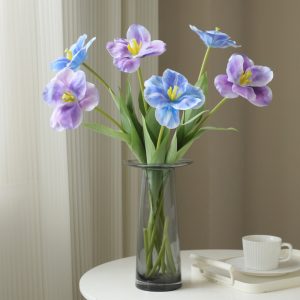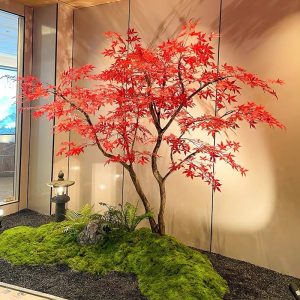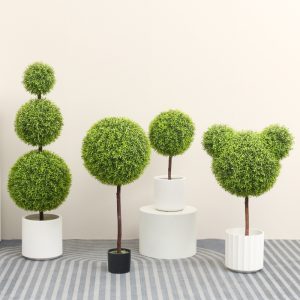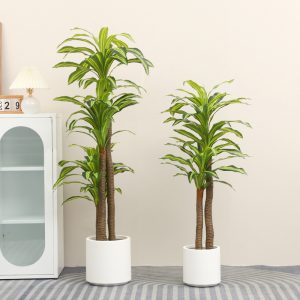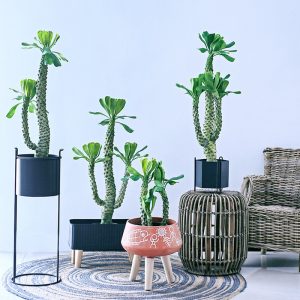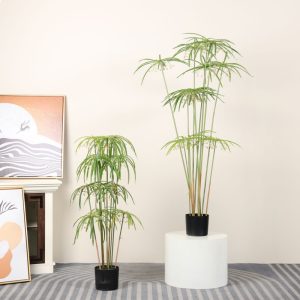At six in the morning in London, the late autumn sun filters through the old iron windows of a new industrial-style restaurant in Shoreditch, casting plaid patterns on the concrete floor. I stand with restaurant designer Mia in the newly finished dining area, watching the cleaner, Izzy, gently brush the leaves of the plants in the corner with a soft-bristled brush. The feathery fronds flutter slightly in the light, like a group of green butterflies at rest. “The texture of this artificial tree fern is incredible,” Mia can’t help but squat down to take a closer look, her fingers brushing the edge of the leaves with a faint rustling sound. “Last week, during the trial opening, even a botany professor was studying the spores, and no one noticed it was artificial.”
The restaurant is filled with the scent of freshly baked sourdough bread and the subtle bitterness of cold brew coffee, blending into a lazy morning atmosphere. In the space with four-meter-high ceilings, several clusters of artificial tree ferns are scattered along the exposed red brick columns — the cluster closest to the entrance is the tallest, with deep brown artificial tree fern stems wrapped in dry scales, and the tripartite feathered fronds unfurling from the top, their dark green leaflets curled with natural waves, resembling green lace unfurling in the morning light. Most remarkable is the partition between the open kitchen and dining area, where tree ferns pair with an iron flower stand, the leaves hanging over the wooden bar, infusing the air with a damp, jungle-like atmosphere. The artificial tree ferns used in this restaurant are weaving a wild yet gentle vision of a natural sanctuary for the guests.

Light, Shadows, and Texture: The Spatial Poetry of the Artificial Tree Fern
Walking through the dining area toward the terrace, Mia suddenly stops in front of a vintage mirror. “Look at the curve of this new leaf; even the branching angles of the veins are identical to those of the real tree fern.” I lean in closer and notice that the leaf surface has a subtle matte texture, and the spores on the back of the leaf are arranged in a natural pattern, just like a plant freshly transplanted from the depths of the rainforest. When the sunlight strikes at an angle, the dark green leaves filter the light into a soft green glow, with spots of light moving slowly across the floor, like fireflies.
The bar area is arranged with even more thought. In the industrial-style space with a walnut bar and black metal supports, small artificial tree ferns hang from the ceiling racks above each seat. The feathery fronds glow softly under the warm lighting. Bartender Jake shakes a mojito, laughing, “Since we switched to these artificial plants, I no longer have to clean up dead leaves in the glasses every day.” He gently moves a leaf, and the stem’s flexibility makes the leaf naturally sway. “The most surprising thing is the customer feedback — many people say the greenery makes the bar feel like a ‘small tavern in the rainforest,’ and even the orders for tropical cocktails have increased by 30%.”
In the afternoon, at the window-side booth area, the sunlight filters through the curtains, casting hazy patterns on the linen carpet. On a small cabinet between the two round tables, a medium-sized artificial tree fern stretches out its fronds. A few friends are taking pictures of their brunch, and their phone cameras inadvertently capture the fern’s leaves in the frame. I notice the fine, natural imperfections on the leaf edges, almost like they’ve been gently nibbled by insects, perfectly replicating the real tree fern’s natural growth. “When we had real tree ferns, the leaves would become brittle after three days without watering,” explains waitress Lila, walking by with a water jug. “These artificial tree ferns don’t need moisturizing, and the leaf spread is more stable than the real plants. Customers always say, ‘This fern looks so full of life.'”
The Rational Choice: Why Premium Restaurants Prefer Artificial Tree Ferns
“At first, the boss was worried that using artificial plants would lose the natural wild feel,” Mia gently strokes the tree fern leaves next to the pillar, recalling the early controversy in the project. “He thought ‘fake plants’ wouldn’t match the restaurant’s ‘pristine natural’ concept, until we did a three-week comparison experiment.” She points to comparison photos in the storage room: real tree ferns in the air-conditioned room, their leaves curling and edges turning brown; ordinary artificial ferns with stiff leaves, reflecting light like plastic under direct sunlight; while this batch of artificial tree ferns made from high-performance eco-friendly materials not only has leaves that unfurl just like real ones but also offers a more layered color transition under different lighting conditions.
Restaurant manager Owen comes over holding the maintenance records, revealing deeper advantages. In the narrow corridor from the kitchen to the dining area, several clusters of artificial tree ferns grow along the wall shelves, their leaves unaffected by the oil and steam, which would normally make real ferns oily and wilted. “The humidity here is over 70% year-round. When we had real tree ferns, the roots would rot in two weeks,” Owen wipes a leaf with a wet tissue. “These artificial tree ferns have an oil- and water-resistant coating, and cleaning them is as simple as a wipe, which is so important for the restaurant’s hygiene standards.” He flips through the cost sheet, smiling, “Since we switched to artificial tree ferns, the labor costs for plant maintenance have dropped by 60%, saving nearly 7,500 pounds annually.”
Procurement consultant Zoe emphasizes in the office while displaying the testing report, “For B2B clients in Europe and the U.S., safety and compliance are the bottom line.” She points to the EU food contact certification on the report, saying that the materials of these artificial tree ferns are free from phthalates, ensuring they are completely safe even if food residues get onto the leaves. “Last week, a customer with a baby left a comment saying the child loved touching the ‘feathery plants,’ and after checking, she found the leaf edges were soft and completely safe from scratches,” Zoe adds. This combination of wild aesthetics and safety is precisely the quality that commercial buyers value most.
Dawn to Dusk: The All-Weather Aesthetic of the Restaurant’s Artificial Tree Ferns
The dining experience at night is full of charm. Warm yellow string lights hang from the beams, giving the artificial tree ferns’ leaves a golden edge. The main cluster near the entrance is illuminated by spotlights, and the dark green leaves appear dusted with fine gold powder. The shadow of the fronds moves gently on the red brick wall, resonating with the melody of a vinyl record in a soft rhythm. Night manager Tara says, “Guests love taking pictures next to these ferns, especially couples, saying the light and shadows on the leaves look like ‘starlight in the rainforest.'” She flips through the social media posts of guests, and even under dim lighting, the tree ferns still retain clear outlines, without the plastic shine of ordinary artificial plants.
In the early morning prep area, the chefs are busy preparing breakfast ingredients, and the artificial tree fern in the corner still stretches out its fronds. Pastry chef Freya, kneading dough, says, “When we had real tree ferns, the heat from the oven caused the leaves to curl up, and we were worried about water leaking onto the flour bins.” She points to the leaf’s texture: “Look at the three-dimensional detail of these artificial leaf veins — even the shadows cast by the light are identical to real ones. The chefs say it’s much more comfortable to glance at this green rather than the white walls.”







